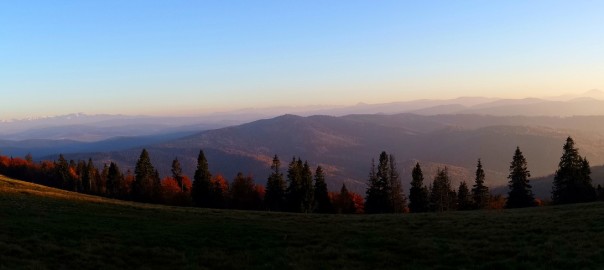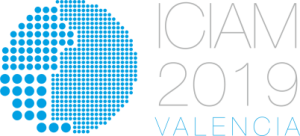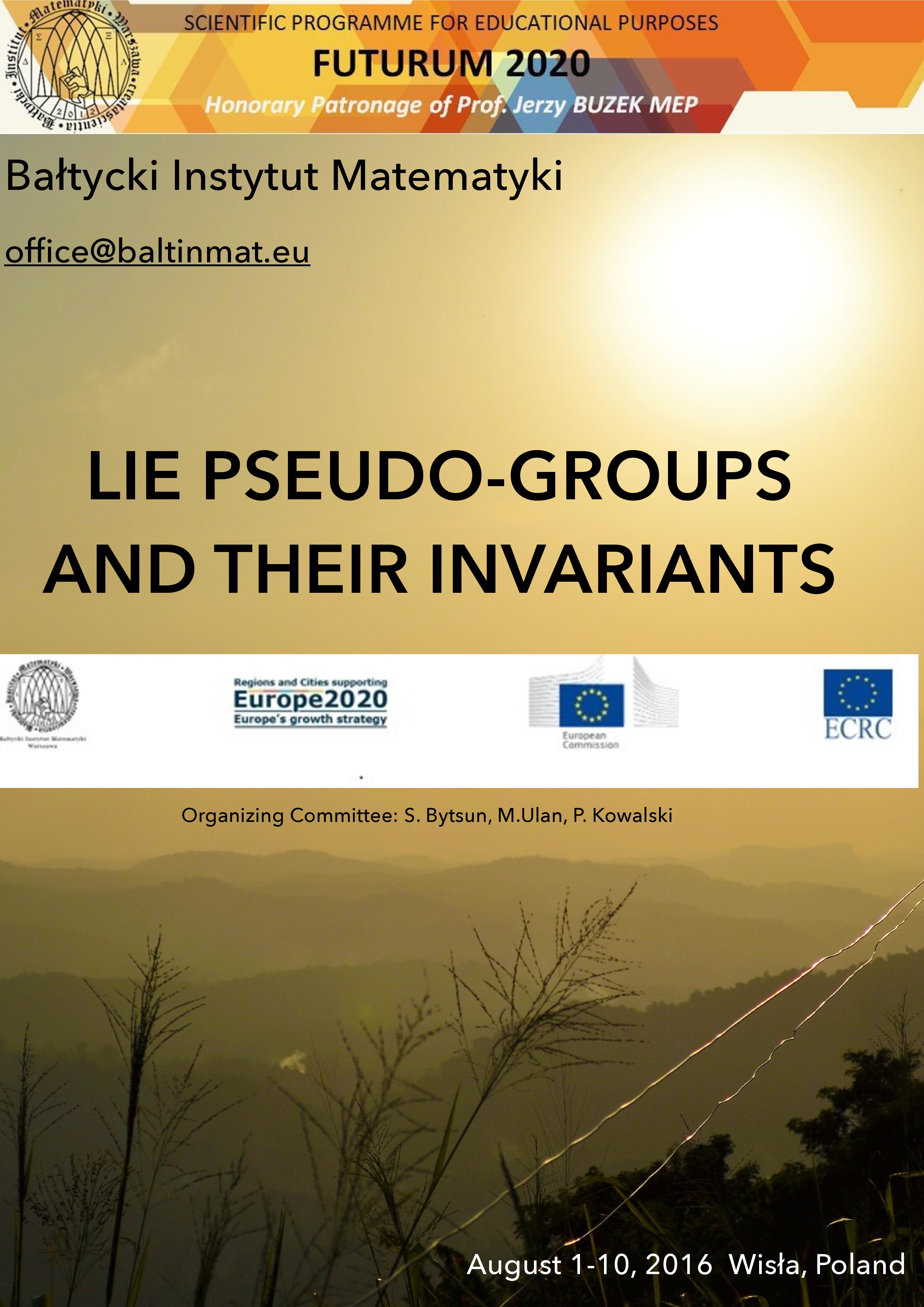Online
January 25 - February 5, 2021
The topic of the school:
Groups, invariants, integrals, and moving frames.
The goal of the school is to present recent results in differential geometry related to nonlinear PDEs, mathematical physics, and moving frames.
LECTURES
January 25 - January 29:
Valentin Lychagin (University of Tromsø, Norway)
Differential contra algebraic invariants.
Eivind Schneider (University of Hradec Králové, Czech Republic)
Differential invariants of Lie pseudogroups.
February 1 - February 5:
Peter J. Olver (University of Minnesota, USA)
The Theory and Applications of Moving Frames.
Volodya Roubtsov (University of Angers, France)
Poisson algebras.
The lectures will focus on Lie groups and pseudogroups which play an important role in these fields, and we will discuss different ways of studying their orbit spaces. Two main topics are Poisson algebras and differential invariants. The theory will be illustrated by examples from algebraic and differential geometry, fluid dynamics, and thermodynamics.
The third main topic is moving frames. The lectures will center on the basic theory, computational techniques, and applications of the new, equivariant approach to the method of moving frames, concentrating one the case of finite-dimensional Lie group actions. The methods will be illustrated by examples chosen from an ever-expanding range of applications, including differential geometry, partial differential equations, calculus of variations, geometric flows, integrable systems, classical invariant theory, numerical analysis, and image processing including the automatic reassembly of broken objects: jigsaw puzzles, egg shells, and bone fragments.
The school will provide young researchers with an opportunity to interact with their colleagues and well-known researchers in the field. Selected materials of the school and workshop will be published by Springer Nature.
PRESENTATIONS
Singularities in Euler flows: multivalued solutions, shock waves and phase transitions by Mikhail Roop (January 25 19:30 - 20:00) Abstract: We analyze various types of critical phenomena in one-dimensional gas flows described by Euler equations. We give a geometrical interpretation of thermodynamics with a special emphasis on phase transitions. We use ideas from geometrical theory of PDEs (symmetries, differential constraints) to find solutions to the Euler system. Solutions obtained are multivalued, have singularities of projection to the plane of independent variables. We analyze the propagation of the shock wave front along with phase transitions.
Vector Distribution and Applications by Ly Hong Hai (January 26 19:30 - 20:00) Abstract: The present theory of variational ODE is based on the theory of distributions of generally non-constant rank, and on the calculus of variations on fibered manifolds. The aim of my talk is to summarize the main concepts and results related to Vector distributions on manifolds, Integral mappings of distribution, Completely integrable distributions, Frobenius theorem, Vifljancev theorem, Foliation of the manifold, Foliation associated with the completely integrable distribution as well as some vivid example to illustrate this theory more clearly. In addition, I will introduce Exterior Differential System, basic examples and applications of scalar first order PDE, Lie Groups.
Invariant difference Euler-Lagrange equations by Lewis Charles White (January 27 19:30 - 20:00) Abstract: In this talk I will introduce moving frames for the difference calculus of variations. I will show how (difference) moving frames can be used to calculate the difference Euler-Lagrange equations directly in terms of the invariants. A running example will be used throughout to illustrate this theory more clearly.
Monge-Ampère Operators and Variational Problems by Radek Suchánek (January 28 19:30 - 20:00) Abstract: We will be focused on Monge-Ampère operators and how they are related with (classical) variational problems. The contact structure that naturally lives on the first jet space of real-valued functions yields a symplectic structure on the corresponding Cartan distribution. In this context, I will define the Euler operator and demonstrate how this operator is connected with the (non)existence of a first-order Lagrangian for a given PDE. The main example will be the second heavenly equation of Plebański, coming from the (anti)-self-dual gravity in dim=4. At the end of the talk, we will see how the above can be connected with the multisymplectic geometry.
Homotopy types of striped surfaces and applications by Aleksei Nikitchenko (January 29 19:30 - 20:00) Abstract: Striped surface is a surface obtained by gluing open stripes with boundary intervals along some of those intervals. Every such surface is a non-compact two-dimensional manifold which can be non-connected, non-orientable and each connected component of its boundary is an open interval. To each striped surface one can associate 1-dimensional CW-complex (topological graph), which encodes combinatorial information about gluing of stripes. This graph can have loops and multiple edges. We prove that there is homotopy equivalence between a striped surface and its graph. The proof is based on one of generalization of Seifert's–van Kampen's theorem for grupoids. One of consequences is that homotopy type of corresponding graph is determined only by the striped surface itself and does not depend on a decomposition this surface into stripes (because surface can have many distinct decompositions into stripes). Each striped surface admits a certain canonical one-dimensional foliation. There is a result by W. Kaplan (1942) that for every stripe decomposition of a plane there is a pseudo-harmonic function on the plane without singular points such that its foliation into connected components of level sets coincide with the canonical foliation of the decomposition into stripes. It also follows that the group of automorphisms of the graph of the stripes decomposition encodes certain combinatorial symmetries of the above pseudo-harmonic functions. So results that we obtain might be useful in the theory of pseudo-harmonic functions and in studying symmetries of PDE.
Chern classes in the context of Hamiltonian monodromy by Nikolay Martynchuk (January 16:00 - 16:30) Abstract: In this talk, we will show how Chern classes can be used to prove the non-existence of global action-angle coordinates in integrable Hamiltonian systems. In particular, we will show that in systems with a global circle action, Chern classes essentially determine the Hamiltonian monodromy. The talk is based on joint works with Prof. K. Efstathiou (Duke Kunshan University).
Symplectomorphisms of surfaces preserving a Morse function by Sergiy Maksymenko (January 30 16:30 - 17:00) Abstract: Let M be a compact orientable surface equipped with a symplectic differential 2-form w. Since its dimension equals to the dimension of M, this form w is also a volume form and so for every open subset U of M one can define a w-area Aw(U) of U by integrating w over U. Furthermore, given a smooth function f on M one can define the so-called Hamiltonian flow H of f with respect to w. This flow is a family of diffeomorphisms Ht, (t is any real number), preserving the function f and the form w in a natural sense:
- f(H_t(x))=f(x) for all x from M,
- Ht*w = w, which means that Ht preserves w-area of each open subset U of M, i.e. Aw(Ht(U)) = Aw(U).
Let S(f,w) be the group of all diffeomorphisms h of M preserving f and w in the above sense, and Sid(f,w) be its itentity path component, consisting of diffeomorphisms isotopic to the identity map of M in S(f,w). Let also Z(f,w) be the abelian group of all smooth functions on M which take constant values along orbits of H.Suppose f is a Morse function.We construct a homomorphism of groups q: Z(f,w) → Sid(f,w) being also a homeomorphism whenever f has at least one saddle critical point or an infinite cyclic covering otherwise. This, in particular, implies that Sid(f,w) is an abelian topological group being either contractible or homotopy equivalent ot the circle.
Cartan Connection for Schrodinger equation by Radosław Kycia (January 30 17:00 - 17:30) Abstract: I will present the Schrodinger equation's factorization into the (elliptic) background and (evolutionary) part moving on this background. It is a slightly generalized picture than in the pilot-wave theory of Quantum Mechanics. Moreover, if the Schrodinger equation is interpreted as a continuity equation, then the Cartan connection appearing in this equation describes the background. Therefore, the splitting into equation and the background can be interpreted geometrically. The vital role in this approach plays the scaling/dilation group of the wave function. This corresponds to the original idea of Weyl that leads to the concept of the gauge principle.
Foliated Lie systems: Theory and applications by Javier de Lucas Araujo (January 30 18:00 - 18: 30) Abstract: An $\mathcal{F}$-foliated Lie system is a non-autonomous system of first-order ordinary differential equations on a manifold N whose main properties are that its particular solutions are contained in the leaves of a foliation $\mathcal{F}$ of N and all its particular solutions within any leaf of $\mathcal{F}$ can be written as a certain function, a so-called foliated superposition rule, of a family of particular solutions of the system within the same leaf and several parameters. I will analyse the properties of $\mathcal{F}$-foliated Lie systems and I will illustrate their properties by studying Lax pairs and a class of t-dependent Hamiltonian systems. Finally, I shall study how $\mathcal{F}$-foliated Lie systems can be studied through geometric structures. In particular, a class of $\mathcal{F}$-foliated Lie systems on Lie algebras will be studied via Poisson structures induced by r-matrices.
Poisson Structures in Diole algebras by Jacob Kryczka (January 30 18:30 - 19:00) Abstract: We summarize a new algebraic formalism for studying calculus in vector bundles. This is achieved by studying various functors of differential calculus over a novel graded commutative algebra called Diole algebras. In doing so, analogues of differential forms as skew-symmetric multi-linear functions on Der-operators arise, leading to so-called Der-complexes and natural generalizations of Atiyah sequences of a vector bundle are found.
A geometric framework to compare classical field theories by Lukas Barth (January 30 19:30 - 20:00) Abstract: A rather philosophical question is how to compare two classical physical theories. However, this question has practical implications because a comparison might enable us to transfer ideas and methods from one area to another. Since classical field theories are to a large extent described by their underlying PDEs, a mathematically more precise question is how to compare differential equations in general. In this talk I'll define a notion of "shared structure" of two systems of (possibly non-linear) PDEs by introducing a suitable notion of intersection of such systems. More concretely, the PDEs will be comprehended as submanifolds of jet spaces and a correspondence between those jet spaces then gives rise to a geometric intersection. It will be argued that if this intersection is a formally integrable manifold, then it can be justified to say that the two theories share structure. Using the notion of shared structure, one can also define a sort of equivalence of theories and equivalence of such theories up to symmetries. This will be illustrated with some examples of subtheories of electrodynamics.
Classification of coadjoint orbits for symplectomorphism groups of surfaces by Ilia Kirillov (January 30 20:00 - 20:30) Abstract: Hydrodynamical Euler's equation describes the motion of an ideal incompressible fluid on a Riemannian manifold. In this talk, I will start by explaining how the kinematics of Euler's equation is related to the coadjoint orbits of the group of volume-preserving diffeomorphisms. In dimension two the volume-preserving diffeomorphisms coincide with the symplectomorphisms. The classification of generic coadjoint orbits for symplectomorphism groups of closed surfaces was obtained by Izosimov, Khesin, and Mousavi in 2016. I will explain how to generalize this result to the case of symplectic surfaces with boundary.
On invariant operations of a manifold with a linear connection and an orientation by Raúl Martínez-Bohórquez (February 1 16:30 - 17:00) Abstract: The theory of natural operations in differential geometry has a long history. Model results in this theory produced explicit descriptions of all natural operations of a certaind kind; that way, there appeared characterisations for many various differential operations, such as those for the exterior dierential, the Lie bracket or the characteristic classes in Riemannian geometry. This talk is based upon a follow-up on a previous work (On the uniqueness of the torsion and curvature operators, by Gordillo-Merino, Martínez-Bohórquez and Navarro, RACSAM 2020). There, an important result by J. Slovak was reformulated in the language of sheaves and ringed spaces, which allowed us to give characterisations of the torsion tensor of linear connections as well as another of the curvature tensor of symmetric linear connections, much in the spirit of the classical results mentioned above. The nice properties of ringed spaces allows us to export this machinery to the setting of manifolds endowed with a linear connection and an orientation, in order to improve the aforementioned characterisations of the torsion and curvature tensors, to describe the space of natural forms and to give a result on the existence of field equations on this environment. This is a joint work with Adrián Gordillo-Merino and José Navarro.
First integrals for SL(2,R) invariant equations with Maple by Concepción Muriel Patino (February 1 17:00 - 17:30) Abstract: In this talk we show how to construct first integrals for a SL(2,R)-invariant ordinary differential equation through algebraic operations involving the symmetry generators of the underlying symmetry algebra sl(2,R), and without any kind of integration. For second-order equations, we provide an explicit expression for two non-constant first integrals, although they could be functionally dependent. For second-order linearizable equations we prove that there are always symmetry generators of sl(2,R) that produce functionally independent first integrals. There are two special cases of non-linearizable equations for which the obtained first integrals become functionally dependent. In this case, a second functionally independent first integral can be obtained by a single quadrature. These results are extended for SL(2,R)-invariant equations of arbitrary order, provided that a solvable structure for an integrable distribution generated by the differential operator associated to the equation and one of the prolonged symmetry generators of sl(2,R) is known. Several examples illustrate the procedures, showing how Maple can help us to perform the computations.
The time-dependent energy-momentum method by Bartosz Maciej Zawora (February 2 16:30 - 17:00) Abstract: In my talk, I will present a new generalisation of the energy-momentum method, designed for studying the stability of a time-dependent Hamiltonian $H(t)$ on a symplectic manifold $(P,\omega)$ with a certain class of Lie group action on $P$ leaving $H(t)$ and the symplectic form $\omega$ invariant. First, I shall introduce some fundamental notions from symplectic geometry and Lyapunov stability such as momentum maps and relative equilibrium points, extending classical results on linear spaces to a time-dependent setting on manifolds. More particularly, I will briefly discuss how the Marsden-Weinstein theorem allows for reducing $H(t)$ on $P$ to a time-dependent Hamiltonian system $K(t)$ on a quotient space of a submanifold $S$ of $P$ induced by a momentum map related to the Lie group action on $P$. I shall comment on the properties of the equilibrium points of $K(t)$ and their relation to the behaviour of $H(t)$ at points of $S$ projecting to them. This will lead to introducing a new relative equilibrium point notion for time-dependent Hamiltonian systems. Then, I will explain some conditions determining the stability points of $K(t)$ and several other related results.
Generalized solvable structures associated to symmetry algebras isomorphic to gl(2,R) \semidirectsum R by Adrián Ruiz Serván (February 2 17:00 - 17:30) Abstract: Symmetry Lie algebras that are isomorphic to $gl(2,R) \semidirectsum R$ are nonsolvable, therefore the standard methods of integration by quadratures cannot be applied to solve ordinary differential equations that are invariant under the action of $GL(2,R) \semidirectsum R$. In this work it is proved the existence of a generalized solvable structure for the vector field associated with a fifth-order equation admitting a Lie symmetry algebra isomorphic to $gl(2,R) \semidirectsum R$. As a consequence, the integrability of the given equation splits into two integration processes of second and third order, respectively. On one hand, two functionally independent first integrals of the equation are computed by quadratures alone. On the other hand, the third order integration process refers to a third-order equation that admits a Lie symmetry algebra isomorphic to $sl(2;R)$, which is also nonsolvable. In this sense, the initial nonsolvability problem is reduced to another nonsolvabilty problem of lower dimension. Previous results regarding the integrability of $SL(2;R$)-invariant third-order equations allow us to obtain the general solution to the original equation in implicit form and expressed in terms of a fundamental set of solutions to a two-parameter family of Schrödinger-type equations. It is also discussed the possible advantages of the approach presented with respect to the standard Lie reduction method. An example is also included with the aim of showing the eectiveness of the method. Remarkably, the Lie symmetry algebra of the considered example is ve-dimensional and isomorphic to $gl(2;R) \semidirectsum R$, which means that the equation does not present extra Lie point symmetries.
Double field theory in supergravity and deformations of supergravity by Stanislav Hronek (February 3 19:30 - 20:00) Abstract: In this presentation, I will review the formalism of double field theory, which is an O(D,D) covariant formulation of supergravity which makes the T-duality symmetry of string theory manifest. It has been shown that this formulation is valid to the first order in α′ (string perturbative expansion). My work in the last year has been connected to using this formalism for studying two aspects of supergravity. The first was to study a deformation of supergravity called the Yang-Baxter deformation which is closely connected to integrable models. It turns out this deformation can be written very naturally in this double field theory formalism. The second was to analyze O(D,D) invariants in higher orders of α′. The goal was to see whether the double field theory formalism can capture the full string α′ expansion. The answer seems to be no since we found an obstruction in the order α′ cubed.
Symmetries of the 2-dimensional Schrödinger-Pauli equation for neutral particles by Serhii Koval (February 4 19:30 - 20:00) Abstract: It is well-known, that the Schrödinger equation (SE) is a very important base for the application of various symmetry approaches to mathematical physics. The symmetry group of SE was established by Sophus Lie a long time ago but in the form of a linear heat equation (but SE is nothing but its complex form). Pauli equation is a partial case of the SE with matrix potentials, which describes the interaction between particles with spin and external magnetic field. By using the algebraic approach the Lie symmetries of 2-dimensional Pauli equation with matrix potentials are classified. Ten inequivalent equations and symmetry groups are specified.
Hamiltonian formalism for quasilinear first order systems through homogeneous operators by Pierandrea Vergallo (February 5 19:30 - 20:00) Abstract: Hamiltonian formalism plays an important role in the theory of Integrable systems. It is a well known fact that Hamiltonian operators map conserved quantities into symmetries of the system. Moreover, finding two compatible Hamiltonian structures of a given system of PDEs allows to generate an infinite number of commuting symmetries (and conserved quantities in involution). This property guarantees the integrability. In general, it is not easy to understand when a given system of PDEs can be written by using Hamiltonian formulations. However, necessary conditions can be presented for a quasilinear system of first order to admit Hamiltonian formulation through a particular class of operators (called homogeneous Hamiltonian operators). In this talk, conditions on rst order and second order operators will be shown with examples and geometric properties.
VIRTUAL SETTING
We use two platforms; Zoom and Discord. All presentations take place on Zoom, and all social interactions take place on Discord. Breaks take place in voice channels on Discord where you can interact with other participants.
The school fee is 100 EUR.
The fee includes online participation, lectures, and covers technical issues.
Registration is closed, since the event already took place.
Financial Support
We expect that some support will be available to fund students and other young researchers. If you are requesting financial support, please complete the registration form and send a pdf of your CV as soon as possible.
Org. Committee
R. Kycia, J. de Lucas, J.Szmit, R.Zawadzki, M.Ulan, M. Wojnowski
#################################################################
Proceedings of Winter School & Workshop Wisla 21
and Summer School & Workshop Wisla 20
Materials of the school and workshop will be published by Springer Nature. The school will provide young researchers with an opportunity to interact with their colleagues and well-known researchers in the field:
- each participant could make a talk about recent research or present a poster
- each participant will get independent and constructive feedback on her/his current research and future research directions
- a decision about including participant’s work to the book will be made based on experts’ feedback
- each participant will also be given an opportunity to improve her/his work during the school
#######################################################################
Lecture notes from previous editions are available at the following links:
Nonlinear PDEs, Their Geometry, and Applications. Proceedings of the Wisła 18 Summer School
Differential Geometry, Differential Equations, and Mathematical Physics. The Wisła 19 Summer School
















